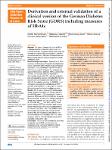Derivation and external validation of a clinical version of the German Diabetes Risk Score (GDRS) including measures of HbA1c
Mühlenbruch, Kristin
Paprott, Rebecca
Joost, Hans-Georg
Boeing, Heiner
Heidemann, Christin
Schulze, Matthias B.
Objective The German Diabetes Risk Score (GDRS) is a diabetes prediction model which only includes non-invasively measured risk factors. The aim of this study was to extend the original GDRS by hemoglobin A1c (HbA1c) and validate this clinical GDRS in the nationwide German National Health Interview and Examination Survey 1998 (GNHIES98) cohort.
Research design and methods Extension of the GDRS was based on the European Prospective Investigation into Cancer and Nutrition (EPIC)-Potsdam study with baseline assessment conducted between 1994 and 1998 (N=27 548, main age range 35–65 years). Cox regression was applied with the original GDRS and HbA1c as independent variables. The extended model was evaluated by discrimination (C-index (95% CI)), calibration (calibration plots and expected to observed (E:O) ratios (95% CI)), and reclassification (net reclassification improvement, NRI (95% CI)). For validation, data from the GNHIES98 cohort with baseline assessment conducted between 1997 and 1999 were used (N=3717, age range 18–79 years). Missing data were handled with multiple imputation.
Results After 5 years of follow-up 593 incident cases of type 2 diabetes occurred in EPIC-Potsdam and 86 in the GNHIES98 cohort. In EPIC-Potsdam, the C-index for the clinical GDRS was 0.87 (0.81 to 0.92) and the overall NRI was 0.26 (0.21 to 0.30), with a stronger improvement among cases compared with non-cases (NRIcases: 0.24 (0.19 to 0.28); NRInon-cases: 0.02 (0.01 to 0.02)). Almost perfect calibration was observed with a slight tendency toward overestimation, which was also reflected by an E:O ratio of 1.07 (0.99 to 1.16). In the GNHIES98 cohort, discrimination was excellent with a C-index of 0.91 (0.88 to 0.94). After recalibration, the calibration plot showed underestimation of diabetes risk in the highest risk group, while the E:O ratio indicated overall perfect calibration (1.02 (0.83 to 1.26)).
Conclusions The clinical GDRS provides the opportunity to apply the original GDRS as a first step in risk assessment, which can then be extended in clinical practice with HbA1c whenever it was measured.

